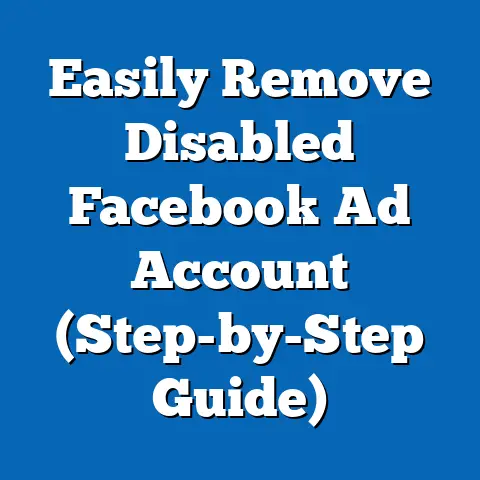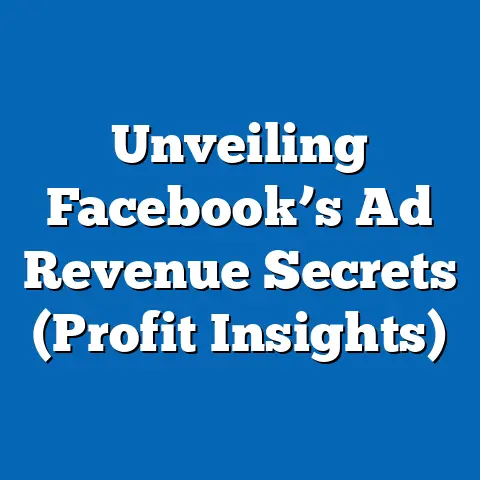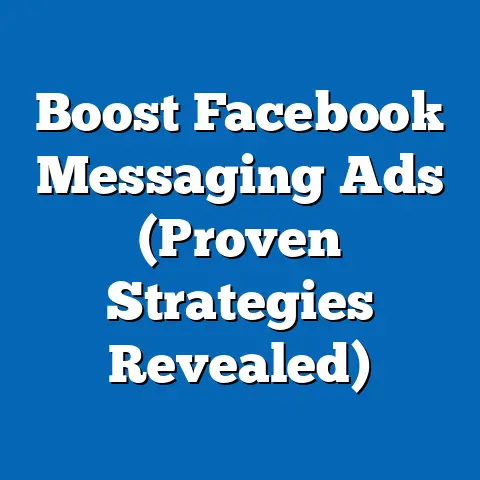Maximize Reach with Bulk Facebook Accounts (Strategic Strategy)
It’s no secret that cracking the code of Facebook advertising can feel like chasing a moving target. I’ve spent years navigating the ever-changing algorithms and competitive landscape, and I’ve seen firsthand how frustrating it can be to create amazing content that barely gets seen. The organic reach that was once a given is now a luxury, and businesses are constantly searching for innovative ways to cut through the noise. What if there was a way to bypass these limitations and significantly amplify your message? The answer, for some, lies in strategically using bulk Facebook accounts.
This guide will explore the concept of using multiple Facebook accounts to boost your marketing efforts. I’ll delve into the intricacies of the Facebook algorithm, the strategic advantages of bulk accounts, the ethical considerations involved, and the practical steps to set up and manage them effectively. My goal is to provide you with a comprehensive understanding of this often-debated tactic, enabling you to make informed decisions about whether it’s the right approach for your business.
Understanding the Facebook Algorithm
The Facebook algorithm is the gatekeeper of your content’s visibility. It determines which posts appear in users’ news feeds and in what order. This complex system analyzes various factors, including:
- Engagement: Likes, comments, shares, and other interactions signal to Facebook that your content is valuable and interesting.
- Relevancy: Facebook tries to show users content that aligns with their interests and past interactions.
- Relationships: Content from friends, family, and frequently interacted-with pages is prioritized.
- Content Type: Facebook may favor certain types of content, like videos or live streams, based on current trends and user preferences.
- Recency: Newer posts generally appear higher in the feed than older ones.
The challenge for businesses is that organic reach has been steadily declining. Studies show that organic reach for Facebook pages can be as low as 2% of their total audience. This means that only a tiny fraction of your followers actually see your posts without paid promotion. I remember launching a campaign for a local bakery, and despite having a dedicated following, our posts were barely reaching a few hundred people organically. This prompted us to explore alternative strategies to boost visibility.
Diversifying your marketing strategies is crucial to overcome these algorithmic restrictions. Relying solely on organic reach is no longer a viable option. You need to explore a mix of paid advertising, content optimization, community engagement, and potentially, the strategic use of bulk Facebook accounts.
Takeaway: The Facebook algorithm is a complex system that significantly impacts your content’s visibility. Declining organic reach necessitates exploring diverse marketing strategies.
The Concept of Bulk Facebook Accounts
Bulk Facebook accounts refer to the practice of creating and managing multiple Facebook profiles for marketing purposes. The underlying idea is that by having multiple accounts, you can increase your presence on the platform, amplify your message, and reach a wider audience.
It’s important to distinguish between personal and business accounts. Personal accounts are intended for individual users to connect with friends and family, while business pages are designed for organizations to promote their products, services, and brand. Using multiple personal accounts for commercial purposes can be a gray area and requires careful consideration of Facebook’s terms of service.
The legal and ethical considerations surrounding the use of bulk accounts are paramount. Facebook has strict rules against creating fake or duplicate accounts, and violating these rules can lead to account suspension or even legal action. It’s crucial to ensure that all accounts are created and managed in compliance with Facebook’s policies. This includes using real names, providing accurate information, and avoiding spammy or deceptive practices. I always advise my clients to prioritize transparency and authenticity in their Facebook marketing efforts.
Takeaway: Bulk Facebook accounts involve creating and managing multiple profiles for marketing. Compliance with Facebook’s terms of service is essential.
Strategic Advantages of Using Bulk Accounts
When implemented strategically and ethically, bulk Facebook accounts can offer several advantages:
- Increased Ad Placements and Visibility: By running ads from multiple accounts, you can increase your chances of reaching different segments of your target audience. Facebook’s algorithm may show ads from different accounts to different users, even if they have similar demographics and interests. This can lead to greater overall visibility and brand awareness.
- Simultaneous Campaign Execution: Managing multiple accounts allows you to run multiple campaigns simultaneously without overwhelming a single account. This is particularly useful for businesses that offer a wide range of products or services or that target multiple geographic regions. I once worked with an e-commerce client who was able to significantly increase their sales by running separate campaigns for each product category across multiple Facebook accounts.
- Enhanced A/B Testing: With multiple accounts, you can conduct more extensive A/B testing to optimize your ad campaigns. You can experiment with different ad creatives, targeting options, and bidding strategies across different accounts and quickly identify what works best. This data-driven approach can lead to significant improvements in campaign performance and ROI.
Let’s look at a real-life example. A travel agency wanted to promote different vacation packages to various demographics. Instead of running all their ads from a single account, they created separate accounts targeting specific age groups and interests. For example, one account focused on adventure travel for young adults, while another targeted luxury cruises for retirees. This approach allowed them to tailor their messaging and ad creatives to each audience, resulting in higher engagement and conversion rates.
Takeaway: Bulk accounts can increase ad placements, enable simultaneous campaigns, and enhance A/B testing, leading to improved campaign performance.
Setting Up Bulk Facebook Accounts
Setting up bulk Facebook accounts requires careful planning and attention to detail. Here’s a step-by-step guide:
- Define Your Objectives: Clearly define your marketing goals and how bulk accounts will help you achieve them. Identify your target audience segments and the specific campaigns you plan to run on each account.
- Create Distinct Branding: Each account should have a unique identity and branding to avoid being flagged as duplicate or fake. Use different profile pictures, cover photos, and descriptions for each account.
- Use Real Information: While you need to create distinct branding, it’s important to use real names and accurate information for each account. Avoid using fake or misleading details, as this can violate Facebook’s terms of service.
- Vary IP Addresses: To avoid being detected as creating multiple accounts from the same location, use different IP addresses for each account. This can be achieved by using proxies or VPNs.
- Gradual Account Creation: Avoid creating too many accounts at once, as this can raise suspicion. Create accounts gradually over a period of time to mimic natural user behavior.
- Follow Facebook’s Policies: Always adhere to Facebook’s terms of service and advertising policies. Avoid spammy or deceptive practices, and ensure that your ads are relevant and targeted to the right audience.
- Organize Your Accounts: Develop a system for organizing and managing your accounts. This could involve using a spreadsheet or a dedicated account management tool.
Remember, compliance with Facebook policies is crucial. Any violation can lead to account suspension or permanent ban.
Takeaway: Setting up bulk accounts requires careful planning, distinct branding, and adherence to Facebook’s policies.
Effective Campaign Management Across Bulk Accounts
Managing advertising campaigns across multiple accounts requires a strategic and coordinated approach. Here are some best practices:
- Integrated Marketing Strategies: Ensure that your marketing strategies are integrated across all accounts. While you can tailor your messaging and ad creatives to each audience, it’s important to maintain a consistent brand message and identity.
- Localized Variations: Allow for localized variations in ad content to resonate with different geographic regions or cultural groups. This can involve using different languages, images, or references that are relevant to each audience.
- Account Management Tools: Utilize tools for managing multiple accounts, such as social media scheduling software, analytics dashboards, and CRM systems. These tools can help you streamline your workflow, track performance, and optimize your campaigns.
- Performance Monitoring: Regularly monitor the performance of your campaigns across all accounts. Track key metrics such as reach, engagement, lead generation, and conversion rates.
- Strategic Adjustments: Based on your performance data, make strategic adjustments to your campaigns. This could involve tweaking your ad creatives, targeting options, or bidding strategies.
I’ve found that using a centralized dashboard to track performance across all accounts is invaluable. It allows you to quickly identify trends and patterns and make informed decisions about how to optimize your campaigns.
Takeaway: Effective campaign management across bulk accounts requires integrated strategies, localized variations, and the use of account management tools.
Measuring Success and ROI
Measuring the success of your bulk account strategy is crucial to determine whether it’s delivering the desired results. Here are some key performance indicators (KPIs) to track:
- Reach: The number of unique users who have seen your ads.
- Engagement: The number of likes, comments, shares, and other interactions your ads have received.
- Lead Generation: The number of leads generated from your ads.
- Conversion Rate: The percentage of users who have taken a desired action, such as making a purchase or filling out a form.
- Cost Per Acquisition (CPA): The cost of acquiring a new customer through your ads.
- Return on Ad Spend (ROAS): The revenue generated for every dollar spent on advertising.
Analyzing data from multiple accounts can be challenging, but it’s essential to gauge overall campaign effectiveness. Look for patterns and trends across accounts to identify what’s working and what’s not. Use this information to make informed decisions about how to optimize your campaigns.
Calculating ROI on your bulk account strategy involves comparing the revenue generated from your ads to the cost of running them. This includes the cost of creating and managing the accounts, as well as the cost of advertising. The potential impact on your bottom line can be significant if your strategy is well-executed.
Takeaway: Track key performance indicators, analyze data across accounts, and calculate ROI to measure the success of your bulk account strategy.
Embracing the Future of Facebook Marketing
Using bulk Facebook accounts presents unique challenges, but the strategic advantages can lead to significant improvements in reach and engagement. This approach requires careful planning, consistent monitoring, and a commitment to ethical practices. It’s not a shortcut to success, but rather a strategic tool that can be used to amplify your marketing efforts.
I believe that this strategy is a viable option for navigating the complex landscape of Facebook advertising and maximizing your marketing efforts. However, it’s important to weigh the risks and benefits carefully and to ensure that you’re complying with Facebook’s policies. The future of Facebook marketing is likely to involve a mix of organic and paid strategies, and bulk accounts can be a valuable addition to your toolkit.
Call to Action:
I’m curious to hear your thoughts and experiences on using bulk accounts in Facebook marketing. Share your insights and questions in the comments below. Let’s foster a community discussion around innovative strategies in this ever-evolving landscape.






